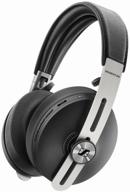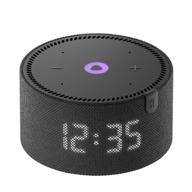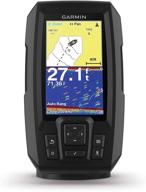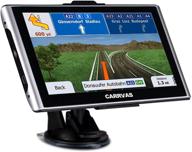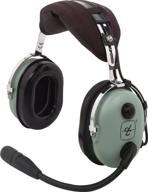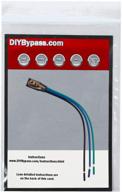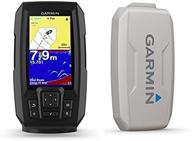Similar products
Choose the right transducer for your needs
The transducer is one of the most important parts of your Garmin Striker Plus 4 fish finder. It is the part that sends and receives the sonar signals in the water. Choosing the best transducer for your needs is crucial to get the most out of your fish finder.
Transducer Types
- Transom mount - Mounts on the transom of your boat
- Trolling motor mount - Attaches to your trolling motor
- In-hull - Mounts inside the hull of your boat
- Portable - Can be moved between boats
The Striker Plus 4 comes with a transom mount CHIRP ClearVü transducer. This sends out wide beams for excellent fish targeting and bottom structure detail.
Considerations
When choosing a transducer, think about:
- Type of boat - Different mounts for different hulls
- Fishing location - Shallow or deep water
- Portability needs - Moving between boats
- Sonar needs - CHIRP, ClearVü, SideVü
Make sure to match the transducer frequency and power to your needs and desired depth. The right transducer will allow you to get crisp and clear scanning to find fish.
With the versatile transducer options of the Striker Plus 4, you can find the perfect transducer to match your specific fishing and boating scenario.
Top products in 🌊 Marine Electronics
Determine the best location to mount the fish finder
Choosing the optimal mounting location is important for getting the best performance from your Garmin Striker Plus 4. The location affects the transducer angle in the water and ease of viewing the display.
Mounting Options
- Transom - Common for outboard motors
- Trolling motor - Useful for fishing trips
- Hull - Inside fiberglass hulls
- Portable - For moving between boats
The fixed transom mount provides stability and works well for planing hulls. Make sure the location you choose has at least 15 cm of flat mounting space and no obstructions.
Ideal Mounting Location
The best place to mount your fish finder is:
- Near the steering console for easy access and viewing
- Away from interference causing electronics
- At least 15 cm from your motor or propeller
- Aligned squarely, not on an angle
The transducer should point straight down, positioned slightly aft of amidships. This gives the best signal strength directly below your boat.
Take time to carefully consider the mounting location based on your boat type and usual fishing grounds. Maximizing performance of your Striker Plus 4 will improve your fish finding capabilities.
Use the CHIRP sonar to find fish
The Garmin Striker Plus 4 uses advanced CHIRP sonar technology to help you find and target fish. Understanding how to use the CHIRP sonar can improve your fish finding capabilities.
How CHIRP Sonar Works
CHIRP transmits a wide range of frequencies in a sweep pattern. This provides a clearer picture of the structures, bottom contour, and fish in the area. The wider bandwidth gives better target separation.
Adjusting the CHIRP Settings
You can fine tune the CHIRP sonar settings for your specific needs:
- Frequency - Adjust between 77 kHz, 83 kHz, and 200 kHz
- Depth - Set the depth range from shallow to deep water
- Gain - Increase or decrease the sensitivity and clarity
- Noise rejection - Reduce interference on the display
Interpreting the Display
Look for key elements on the display:
- Arches - Indicate fish within the sonar beam
- Thick bottom lines - Show harder returns like reefs
- Bait balls - Clumps of small bait fish
The more you use the CHIRP sonar, the better you will get at understanding the display. Mastering your CHIRP sonar will improve your ability to find fish.
Another interesting products
Set up the GPS and mapping features
The built-in GPS and mapping capabilities of the Garmin Striker Plus 4 allow you to mark fishing hotspots and navigate to them later. Properly setting up these features helps you take full advantage of the mapping system.
GPS Setup
To configure the GPS:
- Turn on the GPS from the settings menu
- Let the unit sit stationary while it locates satellites
- Adjust the Heading setting and map orientation
- Enable WAAS for more accurate positioning
Mapping Setup
To get the most out of mapping:
- Insert a mapping SD card if your model supports charts
- Set the map scale to your preference
- Add waypoints on your current location or cursor position
- Set up tracks to record your movement and path
Advanced Settings
Fine tune as needed:
- Alarm radius for arrival/off course warnings
- Change coordinate system between latitude/longitude and UTM
- Adjust the level of map detail shown
With some initial setup, the GPS and maps make the Striker Plus 4 a powerful fishing system. Use the navigation features to find and relocate fishing hotspots.
Read the screen displays and sonar images
Interpreting the screen displays and sonar images is key to getting the most out of your Garmin Striker Plus 4. With some knowledge of how to read the sonar, you can more effectively locate fish.
The Sonar Display
The sonar display shows a visual representation of what's beneath your boat. You'll see:
- Depth - Shown on the right in feet, meters, or fathoms
- Bottom contour - Hard or soft bottom displayed as thickness of return
- Structure - Stumps, weeds, rocks shown as irregular shapes
- Fish - Displayed as arches and fish icons
Adjusting the View
Optimizing the view can improve your fish finding ability:
- Adjust gain to improve contrast
- Reduce noise and interference
- Change depth range to your fishing depth
- Slow the scrolling speed in shallow water
Identifying Fish
Look for key indicators of fish:
- Arches - Fish within the sonar beam
- Schools - Groups of fish clustered together
- Bait balls - Mass of baitfish
Learning to interpret the Striker Plus display takes practice, but will improve your fish finding skills.
Care for and maintain the fish finder
With proper care and maintenance, your Garmin Striker Plus 4 fish finder will deliver reliable performance for years. Simple upkeep is required to keep it in good working condition.
Routine Care
Regular care tasks include:
- Wash the screen with a damp cloth to remove dirt and salt
- Check transducer cable connections are tight
- Test the sounder with manual depth readings
- Update the software when new versions are available
End of Season Maintenance
For storage during the offseason:
- Remove transducer and other accessories
- Clean salt and debris from connectors
- Check mounting hardware for tightness
- Store the head unit and transducer out of direct sunlight
Battery Care
For best battery performance:
- Use a 12V marine battery rated for high discharge
- Turn off the unit when not in use to conserve power
- Avoid draining the battery below 50% charge
- Charge the battery fully before extended storage
With regular cleaning, testing, and care, your Striker Plus 4 will deliver top performance season after season.
How To Install Garmin Striker Plus 4 With Dual-Beam Transducer?
Here is a step-by-step guide on how to install the Garmin Striker Plus 4 with Dual-Beam transducer:
- Choose the location where you want to mount the transducer. It should be in a location that is free from obstructions and turbulence.
- Use a drill to make a hole for the transducer cable to pass through the hull of your boat. Make sure the hole is large enough to accommodate the cable.
- Apply a small amount of electrical putty to the bottom of the transducer and press it firmly against the hull of your boat. Make sure it is level and secure.
- Connect the transducer cable to the back of the Garmin Striker Plus 4 unit.
- Mount the Garmin Striker Plus 4 unit to your boat using the included mounting hardware.
- Connect the power cable to the back of the Garmin Striker Plus 4 unit and connect it to a power source.
By following these steps, you should be able to install the Garmin Striker Plus 4 with Dual-Beam transducer on your boat. If you encounter any issues during the installation process, refer to the user manual or seek assistance from a professional.
What Is The Purpose Of Using A Countersink Bit When Installing The Garmin Striker Plus 4 With Dual-Beam Transducer?
When installing the Garmin Striker Plus 4 with Dual-Beam transducer, it is recommended to use a countersink bit to drill a clearance counterbore through only the top gel-coat layer if you are mounting the bracket on fiberglass with screws. This will help to avoid any cracking in the gel-coat layer when the screws are tightened. The purpose of using a countersink bit is to create a conical hole that allows the screw head to sit flush with the surface of the material being drilled. This helps to prevent the screw head from protruding and causing damage or interference. By using a countersink bit, you can ensure a secure and flush installation of the bracket and transducer. It is important to use the appropriate size and type of countersink bit and follow the installation instructions carefully to ensure a secure and functional installation.
What Is The Difference Between Using A Countersink Bit And A Regular Drill Bit When Installing The Garmin Striker Plus 4 With Dual-Beam Transducer?
The main difference between using a countersink bit and a regular drill bit when installing the Garmin Striker Plus 4 with Dual-Beam transducer is the shape of the hole that is created. A regular drill bit creates a cylindrical hole that is the same diameter as the bit, while a countersink bit creates a conical hole that allows the screw head to sit flush with the surface of the material being drilled. The purpose of using a countersink bit is to prevent the screw head from protruding and causing damage or interference. By using a countersink bit, you can ensure a secure and flush installation of the bracket and transducer. It is important to use the appropriate size and type of countersink bit and follow the installation instructions carefully to ensure a secure and functional installation.
What Is The Recommended Size Of Regular Drill Bits For Installing The Garmin Striker Plus 4 With Dual-Beam Transducer?
According to the installation instructions provided by Garmin, the recommended size of regular drill bits for installing the Garmin Striker Plus 4 with Dual-Beam transducer are:
It is important to use the appropriate size of drill bit and follow the installation instructions carefully to ensure a secure and functional installation. If you encounter any issues during the installation process, refer to the user manual or seek assistance from a professional.






